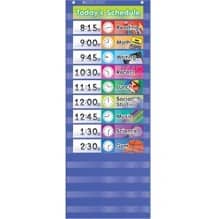The learning environment is an area created by parents, nannies and teachers that a child lives or plays. Positive learning environments in a home, daycare, or school foster emotional, physical, and academic development as everything from wall color to seating arrangements can affect the way a student learns. For children in the early years (ages 1-5), the learning environment plays a critical role in brain development and productivity in later years.
Children learn best when immersed in an environment that engages the child. There are four primary types of learning environments which include integrated, auditory, visual, and social and emotional. Creating a space that integrates these 4 components provides an environment that is respectful and considers a child’s development regarding their social and emotional well-being, their ability to understand and apply verbal direction and appeals to their sense of curiosity while being developmentally appropriate.
1. Integrated.
An integrated environment helps children make connections between their experiences and the world around them by providing young children with activities that foster the development of one or more domains at a time. In this way, new concepts are not taught nor experienced in isolation. A child might engage in learning a specific mathematical concept while also engaging and activating their expressive language skills, hand-eye coordination and social-emotional development.
An example of an integrated activity across multiple domains is a group of children playing at the sand table with different sizes of buckets and shovels. The goal in this activity is to have the children fill the different sizes of buckets full of sand and discuss which bucket might hold the most sand and which bucket might hold the least amount of sand. While they are engaging in bucket selection, shoveling, and sorting, the children are also learning about volume and weight. This is an example of an activity that has integrated more than one concept or developmental domain in a single activity.
In a home setting, it is important to define separate learning spaces so that quiet activities such as reading, writing and drawing are separate from areas where louder activities occur. It is easy to define smaller learning spaces within a larger space using signs indicating what the space will be used for, such as a bean bag chair in a corner with a sign that says, “reading nook”. It is important to provide visual representations of the learning space and the activities that might take place so that children can begin to make the appropriate connections. Once children become familiar with the defined spaces and their requirements it will become easier to develop the activities that will take place in them.
2. Auditory.
Auditory learners are children who process information by listening. Thus, an auditory environment helps to strengthen young children’s verbal-linguistic and auditory processing skills. An auditory environment should be rich in dialogue with lots of discussion between caregivers and the child as well as child to child. Auditory learners enjoy listening to stories and engaging in social activities such as dramatic play and role-playing.
Auditory learners can listen and complete activities without visual representation and enjoy stories with repetitive lines. A childhood favorite is the story of The Gingerbread Man. The repetitive line in this story is “Run, Run As Fast As You Can, You Can’t Catch Me I’m The Gingerbread Man”. When reading repetitive lines aloud, children latch onto the pattern and often repeat it with you. These children enjoy listening and creating music as well as hearing stories read aloud and on tape.
 3. Visual.
3. Visual.
Visual learners process information using their sight. Providing children with visual representation helps their brain process and store new information. Visual aids also help them retain the information especially when the visuals are left up for the children to access when needed.
Young children should be immersed in a print-rich environment. Providing a picture along with a word helps build their visual memory. Labeling materials and items help children learn new words in print from and help them to understand where to put materials back when they have finished using them.
A visual environment might include pictures, labels (such as door, clock, or math center), and other visual aids such as charts, calendars, poems, alphabet charts, and number charts. Visual cues can also include a daily schedule and instructions with pictures such as how to wash hands properly, how to clean up, and how to put toys in proper places.
The visual environment is important to have in any learning space because children make the connections between printed words and language at a young age. Even before children can formally read, they begin to recognize that printed words have meaning. An example is when children recognize the sign M for McDonald’s or they see and understand the meaning of a stop sign.
4. Social and Emotional.
A responsive caregiver strives to meet the individual needs of all children entrusted in their care. Research shows that the relationship between the caregiver and the child can affect the way in which the child forms relationships later in life. Treating each child as an individual with individual needs is an example of being a responsive caregiver and the social-emotional environment is built upon this mentality. It is important to understand that no two children are alike so responding to their needs, needs to be individualized.
Social and emotional environments for children can vary. An important thing to remember when building the social and emotional learning environment is to always address a child at their eye level whether it be to talk with them directly or to redirect the type of behaviors you are witnessing. Young children do not understand sarcasm, so it is never a good idea to use it when talking with them.
To address negative behaviors, it is a best practice not to call attention to the negative behaviors or reprimand a child in front of everyone. Instead, use a gentle touch on the shoulder and redirect them by quietly stating what it is you want them to do. An example of this might be “Please show me you understand how to share your toys.” When the child complies with your request, give them a positive affirmation by saying, “that was a good choice – thank you”.
Children learn about the world around them in multiple ways. Creating a learning environment based on these 4 areas taps into the different learning styles and ways in which children process information.
To learn more, a Learning Environments course is available by enrolling in Nanny Classes, specifically the Advanced Nanny training program.
 About the Author: Annemarie has a Bachelor of Science in Early Childhood Education from Wheelock College and a Master’s degree in Elementary Education from Fitchburg State University. Annemarie is a published children’s picture book author of How the Finch Got Its Colors and a public-school teacher in Massachusetts. Annemarie is an adjunct faculty member of the Nanny Institute and authored a Learning Environments course for Nannies and Sitters.
About the Author: Annemarie has a Bachelor of Science in Early Childhood Education from Wheelock College and a Master’s degree in Elementary Education from Fitchburg State University. Annemarie is a published children’s picture book author of How the Finch Got Its Colors and a public-school teacher in Massachusetts. Annemarie is an adjunct faculty member of the Nanny Institute and authored a Learning Environments course for Nannies and Sitters.


Recent Comments